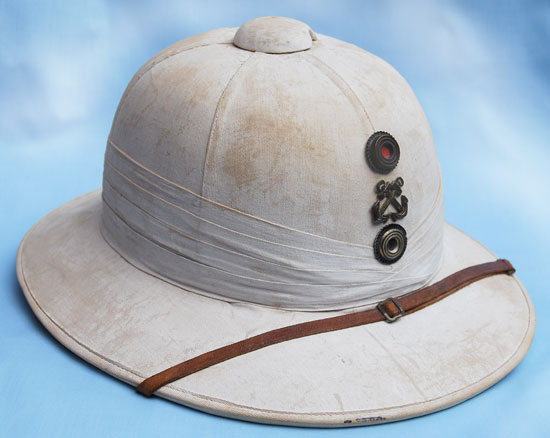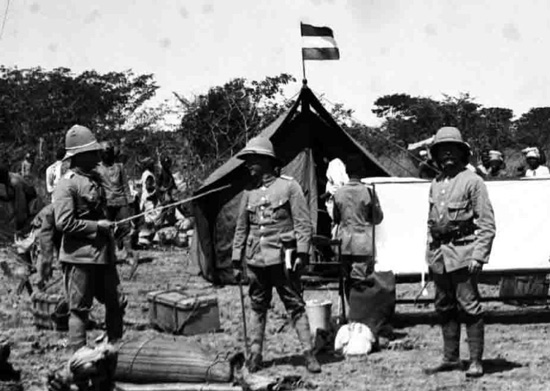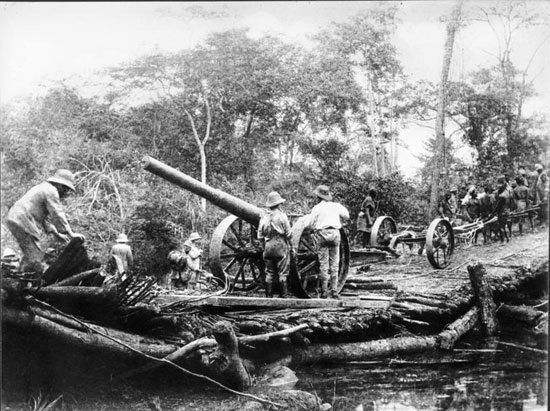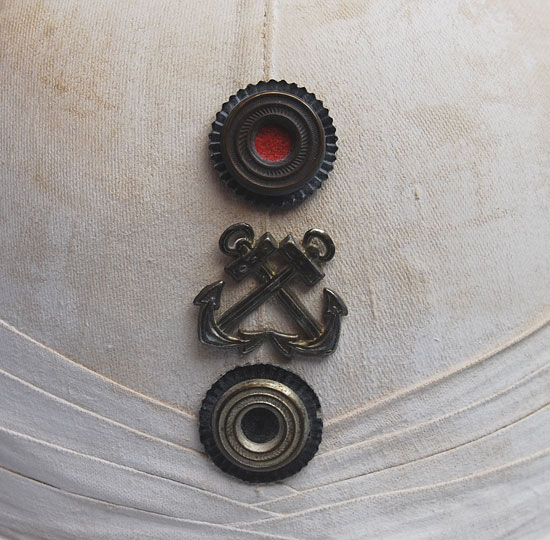
While the bulk of the fighting in the First World War occurred in Europe, notably on the Western Front, the conflict was truly a “World War” as soldiers fought in distant parts of the globe. One of the more colorful tales involved those of Oberstleutnant (Lieutenant Colonel) Paul von Lettow-Vorbeck, who commanded the German colonial forces in German East Africa – today Tanzania.
During this campaign the Germans relied on field-made equipment, and utilized every piece of arms and ordnance at their disposal. Von Lettow-Vorbeck increased the strength of his military force by recruiting German colonists and from the indigenous population, but also by requisitioning a full company of sailors from the SMS Königsberg. It is possible the above helmet was used by one of those sailors.
When World War I broke out the colonial governor of German East Africa hoped to maintain neutrality and sit out the war. Things changed quickly due to the presence of the SMS Königsberg, a light cruiser that was tasked with raiding enemy shipping (mainly British) in the Indian Ocean.
The British responded with an attempt to close the ports of Tanga and Dar es Salaam. The resourceful von Lettow-Vorbeck saw quickly that he couldn’t defeat the British forces in Africa, but instead he realized that he could hold down thousands of men that might otherwise fight in Europe.

This photo from 1914 shows that already a variety of helmet patterns were in use in German East Africa.
In this regard he waged a war of attrition with quick raids and constant movement. The British, along with Belgian and later Portuguese forces, essentially chased the Germans across thousands of miles and never defeated them in the field.
As for the SMS Königsberg, it was forced to hide in the Rufiji Delta after needing necessary repairs to its boilers. This kept it from raiding operations but also meant that several British warships were left merely guarding the East African coastline – and were as tied down as the thousands of men chasing the German Schutztruppe.
In December of 1914, when it was clear that the SMS Königsberg wouldn’t be able to head to the open sea, von Lettow-Vorbeck requisitioned a full company of sailors. These men were issued rifles and drilled in dry-land soldiering.

German colonial troops move the guns from the SMS Königsberg. Note that a variety of different helmets and other headgear are seen. The German forces relied on whatever equipment they could make or capture.
The SMS Königsberg did evade the British by hiding in the Rufiji Delta until July 1915, when it finally came under fire from British river monitors. After five hours of constant bombardment the ship suffered enough damage that Fregattenkapitän Max Looff ordered it scuttled. However, the SMS Königsberg would continue to fight on in other ways. Looff ordered the ship’s guns and other usable equipment to be salvaged. The guns were converted into field artillery pieces and coastal guns; and together with the ship’s crew, went on to see service in the East African land campaign under von Lettow-Vorbeck.
This force continued its campaign until November 14, 1918 when British magistrate Hector Croad informed von Lettow-Vorbeck that an armistice had been signed. The undefeated force consisted of just 30 German officers, 125 German non-commissioned officers and other enlisted ranks, 1,168 Askaris, and some 3,500 porters.

The helmet features both German Imperial and Prussian state cockades. It has been suggested that it was used by an officer seconded to the colonies, or service with one of the many naval units that fought in East Africa.
Throughout more than four years of fighting this motley force wore whatever hats and helmets were available, and at the time the wide brimmed sun helmets were the standard headgear for the ships sailors. Of course it is impossible to say for certain whether this helmet – now in the author’s collection – was in fact used in that campaign, but it is of the right style and design. Even if not, it does serve as a reminder of the helmets and headgear that were worn by the German force that returned to Europe undefeated in the field.
Peter Suciu
May 2017
